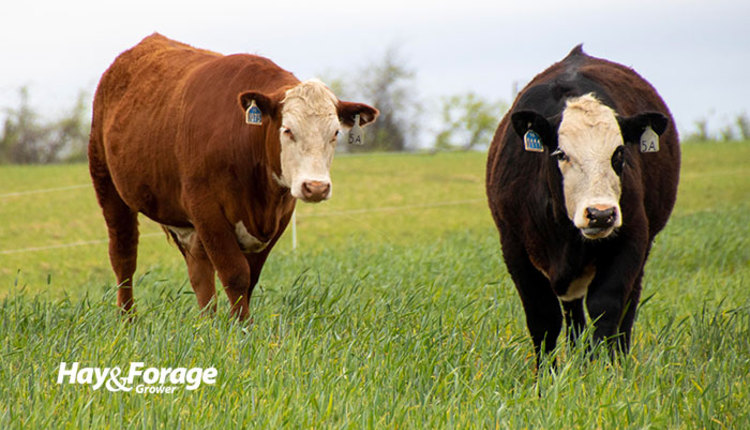Frothy bloat spikes with spring cereal grazing |
| By Amber Friedrichsen, Associate Editor |
|
|
 Concerns and documented cases of wheat pasture bloat are starting to swell as fields of wheat and small grains green up in the Southern Plains. This disease, also known as frothy bloat, causes excessive bloating in cattle that can quickly lead to animal death. In a webinar from Oklahoma State University Extension, Paul Beck explained that frothy bloat results from a buildup of ruminal gasses that are produced faster than they are expelled. The beef cattle nutrition specialist noted the disease is most common in early spring when wheat and small grains are growing rapidly. This forage tends to be high in protein yet low in fiber. Without enough fiber to regulate rumen function, the soluble protein creates a slime layer in animals’ stomachs. “The gasses that are released naturally from rumen fermentation percolate through the slime layer and can block the esophageal orifice, trapping the gas,” Beck said. Cattle can die within 15 to 20 minutes after the initial signs of frothy bloat. The swelling of the rumen can impede on animals’ pulmonary systems, preventing them from breathing and ultimately causing suffocation. A few factors Some additional factors that influence the incidence and severity of frothy bloat are soil fertility and weather patterns. For example, forage growing on more fertile soil may be higher in protein, which heightens the risk of the disease. Warmer temperatures and greater rainfall in the spring accelerate forage growth and exacerbate frothy bloat. Conversely, a late season frost might rupture plant cell walls and intensify the issue as well. In an article from Oklahoma State University Extension published last month, Beck notes death losses from frothy bloat can be as high as 15% to 20% of a cow herd. Even so, this economic loss may be less threatening than not taking advantage of the available forage at all. “Cattle grazing small grain pasture can gain in excess of 2.5 to 3 pounds per day,” Beck writes “Avoiding these pastures based on a fear of bloat is unreasonable, especially when there are affordable and user-friendly methods for control.” Possible prevention Adding low- to moderate-quality hay to animal diets can improve fiber intake and slow the passage rate of grazed forage. Beck stated this may benefit rumen retention time and digestion of wheat and small grains; however, it is not a sure-fire defense against frothy bloat on its own. Feeding cattle monensin is another approach. Research shows this supplement can reduce the incidence of frothy bloat by about 20%, as well as boost animals’ average daily gain. While monensin cannot cure frothy bloat, it can lessen the severity of the condition. “If we are decreasing the severity, it allows us time to see those animals before bloat death occurs and gives us time to provide alternative cures,” Beck said in the webinar. One such alternative is poloxalene, a surfactant that disrupts the slime layer in the rumen and releases trapped gas. Beck suggested providing poloxalene to cattle is a more surefire strategy to prevent frothy bloat if animals consume it daily. It can be found in the form of feed additives, top dresses, mineral supplements, feed blocks, and liquid feed. Beck recommended using a product that is 6.6% poloxalene into animal diets at a rate of 0.8 ounces per 100 pounds of body weight per day. This equates to about 4 ounces of the product per 500-pound animal per day, or 8 ounces of the product per 1,000-pound animal per day.  Amber Friedrichsen Amber Friedrichsen served as the 2021 and 2022 Hay & Forage Grower summer editorial intern. She currently attends Iowa State University where she is majoring in agricultural communications and agronomy. |
